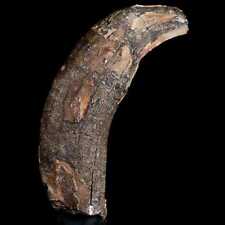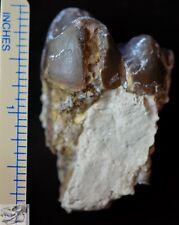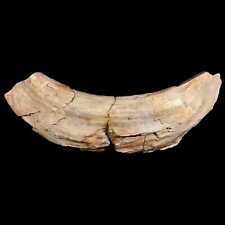Archaeotherium Tooth, Giant Pig Fossil, Badlands, South Dakota, Oligocene, A228 For Sale

When you click on links to various merchants on this site and make a purchase, this can result in this site earning a commission. Affiliate programs and affiliations include, but are not limited to, the eBay Partner Network.
Archaeotherium Tooth, Giant Pig Fossil, Badlands, South Dakota, Oligocene, A228:
$29.95
Ryan's Rare Coins and Antiquities Quality items at an affordable price Fossil Archaeotherium
Type: This is a fossil molar fromthe giantpig,Archaeotherium ingens. Will make a nice addition to the collection.
Locality: Private land in Pennington County, South DakotaAge: Oligocene, 30 Million Years Ago
Read below pictures for information about the area it was found.
Note that ruler increments are 1/16 inch.
Entelodontidae
Giant Pigs, Archaeotherium, Dinohyus
Suoidea - This dramatic superfamily includes the Suididae or true pigs; Tayassuidae or fossil and extant peccaries; and Entelodontidae, extinct pig-like animals that include the well known Archaeotherium and Dinohyus. Entelodonts are extinct bunodont suids which entered North America from Asia during the late Eocene in an already derived format. Large in size, the remains of Archaeotherium are most common in late Chadronian and early Oligocene floodplain environments of the White River Badlands.Few fossils from the Badlands look more incredibly bizarre than the giant pig-like entelodonts. All five genera of this family are characterized by having long massive skulls packed with tusk-like canines, primitive pointed premolars and large, robust molars. Archaeotherium is probably the best known genus but Dinohyus, the last of this family, is the largest and their skulls reached five feet in length. Regardless, the entelodont's brain capacity is very small and they probably functioned largely on instinct.The distinct feature of the entelodont's skull is the enormously developed zygomatic arches. Located under the eyes, these massive bony projections extend laterally and presumably afforded protection to the head and neck when fighting with conspecifics. Pairs of bony knobs also extended downward from the mandibles (lower jaws). Overall, entelodont bodies were powerfully built, boar-like animals with short stocky necks, but with functionally long didactyl feet that are proportionally longer than living suids.Although entelodonts left no ancestors, their dentition suggests they were omnivorous and fed at least as much on vegetation as upon flesh. In the front of the mouth, their incisors are pointed, increasing in size until they reached the large, pointed, recurved canine teeth which, in juvenile stages, were serrated on the lateral surfaces. Premolars are simple compressed conical teeth and dentally, this formula and its masticatory apparatus is much more carnivore-like in form and function. The molars, however, resemble those of modern ursids, a group of carnivores that are surprisingly herbivorous in life.The diets of entelodonts may have been similar to that of most recent suids and peccaries, one comprised primarily of insects, small animals and reptiles, vegetation and roots. The large mandibular warts and narrow maxilla would have been useful when rooting for food as well as when excavating borrows of Stylemys tortoises that were locally abundant during the late Eocene and Oligocene, and when feeding on the burrows' occupants (reptiles, mammals and carrion). They may also have been important scavengers, there being no comparable "hyaena" at that time. Although there were numerous browsing ungulates present in the late Eocene through the early Miocene to provide a ready source of food in the form of carrion, browsing ungulates do not normally form social aggregations large enough to support large predators. Broad floodplain environments do, however, provide ample opportunity for drowning and mass catastrophes. Finally, the teeth, and particularly the enlarged canines, may also have been used in fighting for mates, dominance, food, or territories, and bite marks on the skulls of many specimens are common. Jugal flanges, mandibular tubercles and canine size may also be sexually dimorphic but this has not been proven.Other related groups of the superfamily Suoidea include the much smaller peccaries, Tayassuidae, of which at least 17 genera show similarities to modern day peccaries. Like entelodonts, their teeth were strong and robust, with large tusk-like canines but their skulls were much less massive than those of entelodonts and overall, most fossil peccaries were similar in size to extant species. Unlike entelodonts which became extinct in the late Hemmingfordian NALMA, peccaries are primarily a genera recorded after the start of the Miocene; three genera are still living today. Two additional but poorly understood genera of primitive peccaries are known only from the late Chadronian through the early Arikareean NALMA.Of final note is the Anthracotheridae, an odd blend of hippopotamus and peccary, which are probably most closely related to the oreodonts. In the Badlands area, examples of Bothriodon have been rarely found in Oligocene sandstones.Written by Ryan C.
The White River Badlands
The White River Badlands has been the site of much interest for paleontologists since the mid-1800's. During these early explorations, scientists began finding fossil remains of many large mammals. These interesting discoveries soon attracted prominent paleontologists, such as the famous Dr Joseph Leidy and Prof O. C. Marsh to visit there and conduct more detailed studies. It soon became clear that this area represented a unique area of great scientific value and many museums and universities surged forward to explore these strata as well as to collect fossils from them. Numerous publications were produced discussing these discoveries. Unfortunately most of the publications were very specific to particular discoveries or sites and failed to give a broad picture of this region. It wasn't until 1920 that Cleophas O'Harra of the South Dakota School of Mines published a book on the White River Badlands, the sole purpose of which was to shed light on the area. Sadly, today there remain few useful references beyond this book, which is now over 90 years old.Times have changed. It is time to develop a website showing new fossil discoveries, clear color photographs of specimens, updated taxonomy, fossil preparation techniques and advice from active collectors and dealers who can introduce people to the and the fossils in it.Written by Ryan C.
Geography of the White River Badlands
The White River Badlands is a collection of irregularly shaped, highly eroded areas that extends from the southwestern portion of South Dakota through parts of northwestern Nebraska and eastern Wyoming into eastern Colorado. The drainage pattern of the badlands converges on the White River, hence its name.The badlands themselves are characterized by harsh rugged peaks and steep gullies, with a variety of brown and tan sedimentary layers that lie fully exposed and often capped by flat areas covered in grasses. Early exploration through this region was tough and finding food and water difficult. The area is, however, quite fertile in places and water can be found in shallow wells. Much of the badlands region is used today for grazing of cattle.To help us imagine what the Badlands are like, a quote from Prof. O'Harra, describing Sheep Mountain is appropriate."Sheep Mountain, the cedar covered top of which overlooks all the surrounding country, presents a view that is hopelessly indescribable. In all directions everything is strange and weird to the extreme. Far away cattle or horses may be seen feeding on levels of green, and here and there distant dots indicate the abodes of happy homesteaders. Immediately about all is still.Until recently the sharp eye could occasionally detect a remnant bunch of mountain sheep, once numerous, but quickly and quietly they would steal away to the cover among the intricate recesses of the crumbling precipices. Only an occasional eagle screams out a word of curiosity or defiance as he sails majestically across the maze of projecting points and bottomless pits. Magnificent ruins of a great silent city painted in delicate shades of cream and pink and buff and green! Domes, towers and spires decorate gorgeous cathedrals and palaces and present dimensions little dreamed of by the architects of the ancients."
What a magical depiction!Written by Ryan C.
Quotes from Cleophas C O'Harra
Geology and Age
The White River Group, South Dakota
The oldest rocks in the White River Group are Late Eocene (late Chardonian Age) to mid-Oligocene and range from 30 to 40 million years old. In South Dakota, the Chadron Formation consists of siltstones, sandstones and sandy conglomerates which were deposited in stream channels.At the top of the Chadron Formation, these sediments shift into the Brule Formation which itself is divided into the lower Scenic Member and the Poleslide Member. The Scenic Member dates to the Middle Oligocene, 35 to 32 million years old and is composed of siltstones and sandy siltstones with some infrequent channel conglomerates. The Poleslide Member is Late Oligocene and dates from 32 to 25 million years old. These beds contain sediments which are sandier than the Scenic Member, and like beds in the early Oligocene, contain occasional ash beds.Overall the White River Group was deposited in an alluvial flood plain environment characterized by siltstones, sandstones and lenticular conglomerates. These conditions were perfect to facilitate the preservation of many unique and interesting mammal species.Written by Ryan C.
The environment of the Badlands in the OligocenePaleoclimate of the Oligocene
The climate during the Oligocene was one that is quite different than that of today. By looking at the types of rocks found in these bed and the fossils within them, a picture of the Oligocene paleo-environment begins to reveal itself. The prominence of clays and lenticular sandstones indicates a mature river valley with a relatively flat topography, meandering rivers, punctuated by lakes and swamps. The land may have been covered by small shrub-like vegetation, with perhaps forests in parts. The landscape was populated by a great diversity of animal life, particularly. Mr. O'Harra writes a beautiful description of the life during the Oligocene:"Here the gently flowing streams push their muddy way through reedy marshlands and vigorous forests and furnish a lazy playground for countless turtles and occasional crocodiles. In favored recesses groups of rhinoceroses may be seen, some heavy of bulk and water loving, others graceful and preferring dry land. Little fleet-footed ancestral horses nibble the grass on the hillsides or trot unhindered across the muddy flats. Here and there we see a group of predaceous dogs and not infrequently do we get a glimpse of a ferocious tiger-like cat. On the higher ridges, six horned herbivores reveal their inquisitive pose, and scamper from the nearing presence of some stealthy foe. But the dominating beast is the titanothere. In great numbers we see his majestic form as he moves among his kin and crops at his leisure the coarse grasses of the lowlands. Here and there are gophers and squirrels busy with their toil and their play, and hedgehogs and moles and swine and deer and tapirs and camels, and many other creatures too strange to mention without definition. To all these animals it was home. Here they fought for food and life and supremacy. To them the sun shone, the showers came, the birds sang, the flowers bloomed, and stately trees gave convenient shade to the rollicking young of many a creature.But 'everlasting hills' have their day and rivers do not flow forever. One by one, group by group, they died, the bodies of most of them quickly feeding the surrounding elements but a chosen few, tucked away by the kindly hand of nature, remaining as unique monuments of the dawning time of the great mammalian races, are now being revealed as gently by nature again in these days of man."Such a vibrant description!Written by Ryan C.
Quotes from Cleophas C O'Harra
Thank you for visiting!

Related Items:
4.6" Archaeotherium Entelodont Pig Canine Fossil Tooth Oligocene Age Badlands SD
$235.99
Rare Giant Pig Lower Molar, Archaeotherium Fossil, Oligocene, South Dakota, A294
$89.95
5.9" Archaeotherium Entelodont Pig Canine Fossil Tooth Oligocene Age Badlands SD
$215.99



